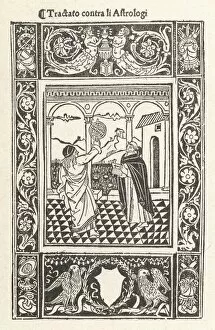1497 Collection (page 7)
In the year 1497, a remarkable blend of art, satire, and historical events unfolded across Europe and Russia
For sale as Licensed Images
Choose your image, Select your licence and Download the media
In the year 1497, a remarkable blend of art, satire, and historical events unfolded across Europe and Russia. One such illustration that captured the essence of this era was found in Sebastian Brant's book Ship of Fools. Created anonymously, this satirical artwork provided a glimpse into society's follies. Meanwhile, medical practices were evolving as evidenced by a medical prescription from that time. The study of medicine became intertwined with advancements in various fields like art and science. It was also during this period that Philipp Schwarzerd, known as Melanchthon (1497-1560), made significant contributions to education and theology. The political landscape saw Lady Catherine Gordon standing before King Henry VII. Her presence symbolized the intricate alliances formed between countries during this era. Another notable figure was Perkin Warbeck who sought refuge at Beaulieu Abbey in the New Forest amidst political turmoil. Artistic brilliance thrived as Leonardo da Vinci delved into his studies while leaving an indelible mark on history through his works like Codex Atlanticus. Simultaneously, Johannes Gutenberg's printing press revolutionized communication by making books more accessible to people across Europe. Catherine of Aragon emerged as a prominent figure during these times when she ascended to become Queen of England in 1485 until her death in 1536. Her influence extended beyond her role as queen and left an enduring legacy. Alexander Barclay's English translation of The Ship of Fools shed light on societal issues prevalent at the time through engravings depicting tales bearers, false reporters, promoters of strife, and those who refused to acknowledge their own foolishness or fought against stronger opponents. Hieronymus Brunschwig's Book of Cirurgia showcased advancements in surgical techniques through lithographs—a testament to progress not only in medicine but also technology itself. The year 1497 encapsulated an era marked by artistic expression, scientific breakthroughs, political intricacies, and societal introspection.


